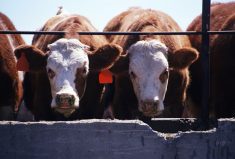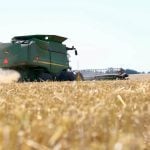Western Canadian feeder cattle markets traded $5 to $8 below week-ago levels; noticeable declines were noted in the lighter weight categories, which were down $6 to as much as $10.
Adverse weather continues to plague the feedlot regions of Alberta and Saskatchewan. Another snowfall over the weekend caused pen conditions to erode to lowest levels of the year. The harsher environment also hindered Alberta feedlot demand in eastern Saskatchewan and Manitoba. Certain pockets of the Prairies appeared to incorporate a risk discount with buyers factoring in above-normal death loss. Many cattle coming on the market are bearing heavier flesh levels as sellers shudder at the recent drop in prices. Cattle that should have been sold in early March are now flowing into the auction rings and quality has deteriorated.
Read Also

GIWA trims Western Australian crop forecasts, still predicts record harvest
The Grain Industry Association of Western Australia (GIWA) slightly lowered its estimates for the state’s 2025/26 production of wheat, barley and canola on Friday but said the harvest of winter crops was still on track to be the biggest ever.
A larger group of tan mixed medium- to heavier-flesh steers weighing just under 950 lbs. were quoted at $153 landed in southern Alberta; Angus-based fleshier heifers averaging 950 lbs. were valued at $140 in the same region. Alberta packers were buying fed cattle in the range of $154-$155 delivered, down $4-$5 from last week. Margins are moving into red ink territory, setting a negative tone for the heavier yearlings.
The bottom appeared to fall out of the calf and grasser markets last week. Feedlot interest in the lighter weight categories has evaporated, given difficult weather. Pasture conditions will be quite favourable if warmer temperatures come around; however, the fall market for yearlings looks quite weak. Feedlots are factoring in higher costs per pound gain and the market with the weaker futures; the purchase price has to give. There is also the potential for feedlot equity erosion over the summer, so demand will be softer than last year.
In central Alberta, red white-face mixed steers averaging 525 lbs. traded at $199 while in central Saskatchewan, 525-lb. Angus-cross steers sold for $220. The market was quite variable across the Prairies, however; heifers in the lighter weight categories were discounted quite heavily. A small group of 500-lb. black heifers sold for $170 in eastern Saskatchewan. The U.S. calf crop is now back up to levels similar to 2009, so there are ideas that the feeder market needs to encourage contraction through lower prices. The replacement heifer market will soften and this will contribute to the lower price structure for lighter feeder cattle.
— Jerry Klassen manages the Canadian office of Swiss-based grain trader GAP SA Grains and Produits Ltd. and is president and founder of Resilient Capital, specializing in proprietary commodity futures trading and market analysis. Jerry consults with feedlots on risk management and writes a weekly cattle market commentary. He can be reached at 204-504-8339.















